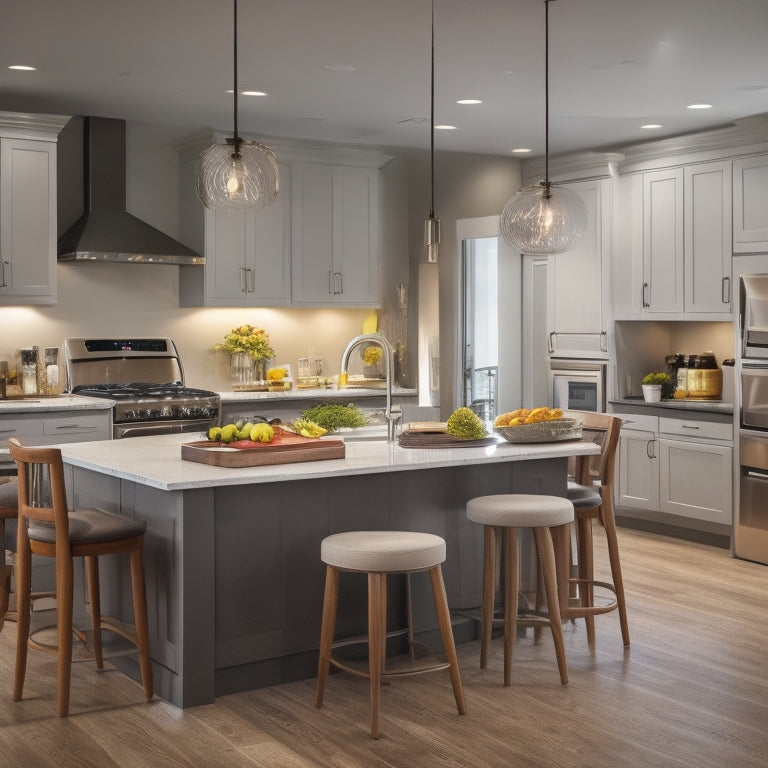
Enhance Dining Experience & Optimize Kitchen Layout
Share
Enhancing the dining experience relies on a well-orchestrated combination of a streamlined kitchen workflow and an inviting outdoor dining space. A thoughtfully designed kitchen layout optimizes workflow efficiency, reduces waste, and promotes food safety. Meanwhile, an attention to detail in outdoor dining areas creates a memorable ambiance, elevating the overall dining experience. From proper food storage to strategic equipment placement, every element plays a crucial role. By mastering the art of kitchen layout and outdoor dining design, restaurateurs can discover the secrets to a truly exceptional customer experience, and there's more to explore in achieving this harmony.
Key Takeaways
• A well-designed kitchen layout streamlines food preparation, reduces costs, and promotes safety, enhancing the overall dining experience.
• Effective food storage and organization systems reduce waste, improve efficiency, and maintain food quality, contributing to a memorable dining experience.
• Attention to detail in outdoor dining areas, including ambiance, lighting, and music, creates an inviting atmosphere that elevates the dining experience.
• A cohesive atmosphere that blends ambiance, service, and cuisine is essential for a memorable dining experience, both indoors and outdoors.
• Optimizing kitchen workflow efficiency and prioritizing cleanliness and sanitation are critical for ensuring food safety and customer satisfaction.
Optimizing Kitchen Workflow Efficiency
A well-designed kitchen layout is the backbone of a seamless workflow, as it enables chefs and kitchen staff to navigate the space with ease, reducing congestion and increasing productivity. Proper food container selection and kitchen storage optimization are vital components of this design.
By choosing the right food containers, kitchen staff can efficiently store and retrieve ingredients, reducing waste and improving food safety. Optimizing kitchen storage guarantees that frequently used items are easily accessible, streamlining workflow and minimizing accidents.
A well-organized kitchen layout also promotes a clean and sanitary environment, essential for maintaining a high level of food safety and quality. By prioritizing kitchen workflow efficiency, restaurants can improve customer satisfaction, reduce labor costs, and increase profitability.
Designing Memorable Outdoor Dining
As restaurants aim to create a seamless workflow in their commercial kitchens, they must also consider the importance of extending this efficiency to outdoor dining areas, where a well-designed space can elevate the overall dining experience and increase customer loyalty.
When it comes to outdoor event planning, attention to detail is vital in creating a memorable experience. This includes ensuring a safe and accessible environment for patrons.
A well-designed outdoor dining space can transport customers to a unique atmosphere, enhancing the dining ambiance. By incorporating elements such as lighting, music, and décor, restaurants can create a distinctive and inviting atmosphere that sets them apart from the competition.
Food Storage and Organization Essentials
Proper food storage and organization are critical components of a well-run commercial kitchen, directly impacting food safety, quality, and profitability. When it comes to food container selection, choosing the right ones is essential. Consider factors such as durability, ease of cleaning, and airtight seals to guarantee food freshness and prevent contamination.
Organizing tips include labeling containers, storing heavy items at the bottom, and keeping frequently used items easily accessible. Proper food storage benefits include reduced food waste, improved inventory management, and enhanced kitchen efficiency.
Mastering Commercial Kitchen Layout
Effective commercial kitchen layout is crucial for streamlining food preparation, reducing labor costs, and enhancing overall kitchen productivity.
A well-designed layout guarantees a seamless workflow, minimizes congestion, and promotes a safe working environment. To optimize kitchen layout, consider factors such as equipment placement, traffic flow, and storage.
Implementing efficient organizing techniques, such as labeling and categorizing food container options, can also greatly enhance productivity. By strategically placing frequently used items, minimizing walking distances, and utilizing vertical storage, chefs can focus on food preparation rather than maneuvering through a cluttered kitchen.
Elevating the Dining Experience
To elevate the dining experience, restaurants must focus on creating a cohesive atmosphere that harmoniously blends ambiance, service, and cuisine, ultimately leaving a lasting impression on patrons.
A well-designed outdoor dining ambiance can set the tone for a memorable experience. Consider incorporating elements such as string lights, comfortable seating, and lush greenery to create an inviting atmosphere.
Additionally, themed menu suggestions can add an extra layer of excitement to the dining experience. For example, a summer-themed menu featuring invigorating cocktails and seasonal ingredients can complement the outdoor ambiance.
Frequently Asked Questions
How Often Should I Sanitize My Food Storage Containers?
To maintain food safety, sanitize food storage containers regularly, considering container lifespan and cleaning schedule. Aim to sanitize containers every 1-3 months, or as needed, to prevent bacterial growth and contamination.
Are There Any Eco-Friendly Alternatives to Traditional Food Containers?
When seeking eco-friendly alternatives to traditional food containers, consider sustainable packaging options like biodegradable plant-based containers, compostable bags, and reusable stainless steel or glass containers, ensuring a reduced environmental impact while maintaining food safety.
Can I Use Food Storage Containers for Both Hot and Cold Items?
When selecting food storage containers for both hot and cold items, consider material options like stainless steel, glass, or BPA-free plastic, and choose container sizes that fit your specific needs to guarantee safe and efficient storage.
What Are the Benefits of Using Airtight Food Containers?
Airtight food containers provide a Freshness Guarantee by sealing in flavors and aromas, while also offering a Convenience Factor through easy storage and transport, ensuring food safety and quality.
Are There Any Specific Food Storage Regulations I Need to Follow?
While airtight containers preserve freshness, food storage regulations cannot be neglected. Guarantee compliance by implementing expiry labeling and maintaining precise temperature control, adhering to local health codes to assure a safe and healthy environment for customers.
Related Posts
-

Data Lakes and Warehouses: Unveiling Data Wisdom
Data lakes and warehouses are two distinct data storage solutions that serve different purposes. Data lakes store mas...
